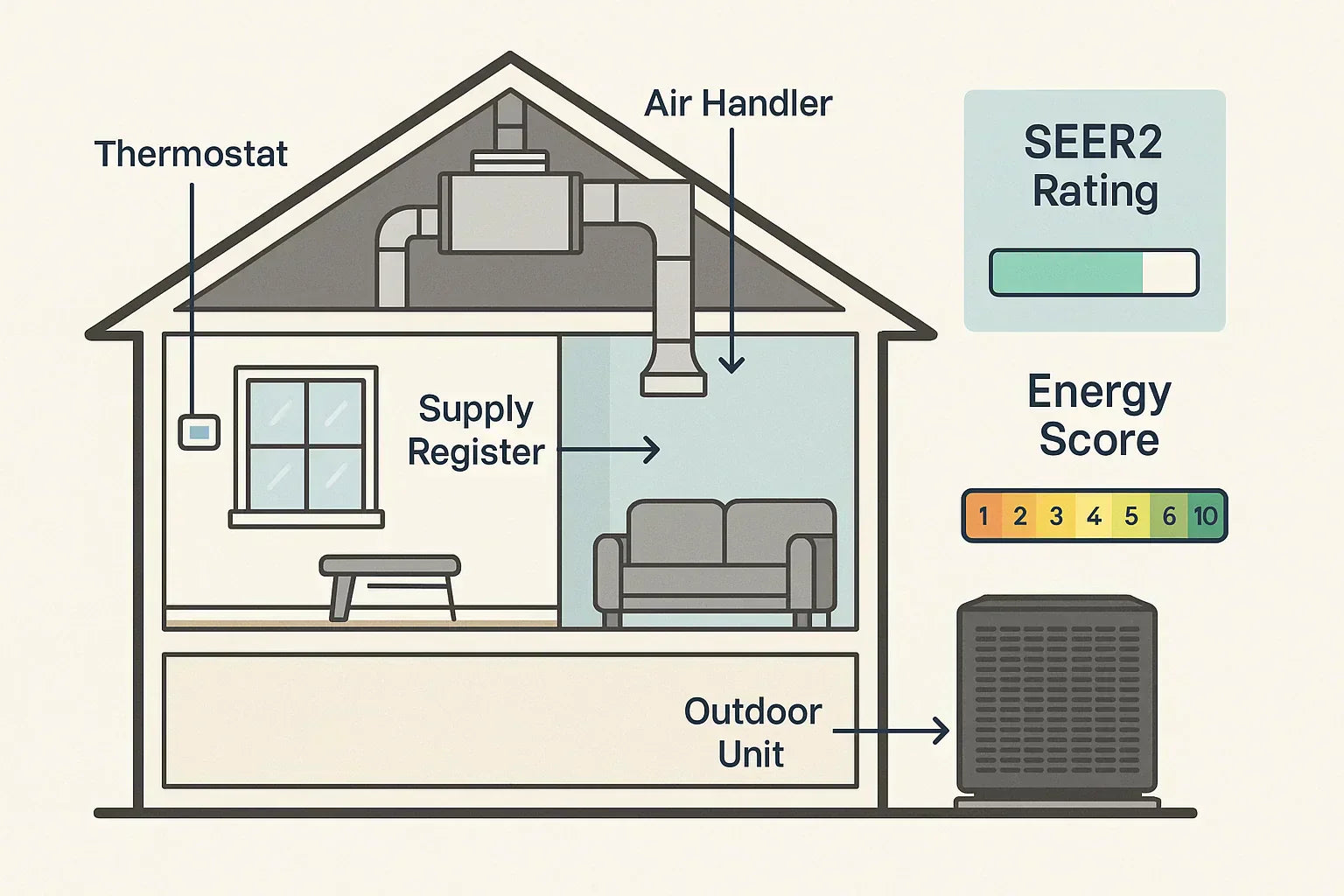If you're buying, selling, or upgrading a home, you’ve probably heard terms like HERS Index, Home Energy Score, and now SEER2. But what do these have to do with each other?
Here’s the simple truth: your HVAC system—especially its SEER2 rating—plays a big role in how your home performs in official energy scoring systems. And that score? It can affect everything from resale value to mortgage eligibility.
In this post, I’ll walk you through how SEER2 ratings tie into your home’s energy performance—and why that matters for homeowners.
📘 Want the full SEER2 background first?
👉 What is SEER2 and Why It Matters
Understanding the HERS Index and Home Energy Score
There are two major systems used in the U.S. to score residential energy performance:
1. HERS Index (Home Energy Rating System)
-
Developed by RESNET, this is the industry standard for rating home energy efficiency.
-
Lower numbers = better performance. A score of 100 represents the energy use of a typical new home. 0 means net-zero.
-
It evaluates insulation, ductwork, air leakage, and most importantly—your HVAC system.
2. DOE Home Energy Score
-
A simpler 1–10 scale, developed by the U.S. Department of Energy.
-
Focuses on energy use from heating, cooling, and water systems.
-
Often used in real estate transactions and energy retrofit programs.
Both systems heavily weigh the efficiency rating of your HVAC system, especially air conditioners and heat pumps.
📘 Better Buildings – About the Home Energy Score
Why SEER2 Ratings Matter in Energy Scoring
Your HVAC system doesn’t just cool the air—it defines your home's energy signature.
That’s where SEER2 comes in.
SEER2 is the latest standard for measuring cooling efficiency under real-world conditions, including duct pressure and airflow resistance. The better the SEER2 rating, the more efficient your cooling system is over time.
When scoring your home, energy raters consider:
-
The SEER2 and HSPF2 ratings of your installed units
-
Whether the system meets or exceeds regional efficiency standards
-
If the system is properly matched (AHRI-certified combo of indoor + outdoor units)
For example, replacing a 10 SEER system with a 17 SEER2 unit can shave dozens of points off your HERS score—or add 2–3 points to your DOE Home Energy Score.
📘 AHRI Directory – Match HVAC System Components
How SEER2 Affects Resale Value and Green Mortgages
Energy scores aren’t just for bragging rights—they’re starting to influence real estate transactions.
-
Appraisers can now include energy data using the Green and Energy Efficient Addendum
-
Homes with better scores and high-efficiency HVAC systems often sell faster and at a premium
-
Certain energy-efficient homes qualify for green mortgage incentives, which may require a minimum HERS score
A SEER2-rated system helps boost your eligibility for these programs—especially if paired with energy-efficient ductwork and smart thermostats.
ENERGY STAR, SEER2, and Certified Homes
If your HVAC system is SEER2-rated and ENERGY STAR® certified, you may already be meeting the HVAC portion of ENERGY STAR Home Certification standards.
These homes require:
-
High-efficiency systems meeting SEER2/HSPF2 minimums
-
Proper duct sealing and airflow balancing (Manual D)
-
Verified installation using quality protocols like those outlined by ACCA’s QI Standard for New Homes
When installed to these standards, your system doesn’t just perform better—it contributes directly to a lower HERS Index or higher Home Energy Score.
Tips to Make Sure Your System Gets Counted
Here’s how to ensure your SEER2 upgrade works for your home energy score:
✅ Keep Your Documentation
-
Save the AHRI certificate
-
Keep a copy of the EnergyGuide label from the unit
-
Record installation details and model numbers
✅ Work with a Certified Rater
-
Let your HERS or Home Energy Score rater know about your HVAC upgrade
-
Provide all paperwork during the energy audit
✅ Verify Equipment Matchups
-
Use the AHRI directory to confirm the system’s match rating
-
Confirm your installer used manual calculations to size ducts and units
SEER2, HERS, and Long-Term Value
Upgrading to a high-SEER2 system does more than just cut utility bills—it sends a message to future buyers that your home is efficient, comfortable, and well-maintained.
If you’re investing in energy-efficient upgrades, HVAC is often the single most influential system when it comes to energy scores—and SEER2 is your benchmark for how well it performs.
🔗 Final Thoughts from Alex Lane
Your HVAC system isn't just a behind-the-scenes machine—it’s front and center in how your home is scored, valued, and marketed. So if you're installing a new unit or getting ready to sell, ask your contractor one key question:
“Is this SEER2-rated—and can I get the documentation to prove it?”
It might be the difference between a mediocre home energy score and one that opens doors to rebates, green financing, or a faster sale.
👉 Next up in this SEER2 series:
Can a Higher SEER2 Rating Make You Eligible for Net-Zero or Green Certification?
Alex Lane
Your Home Comfort Advocate







